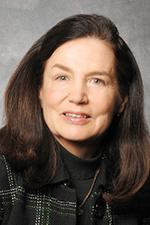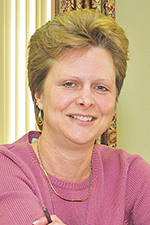By BETSY TAYLOR
Nearly half a million Americans died from drug overdoses from 2002 to 2014, with overdose deaths including deaths from opioid pain relievers and heroin hitting record levels in 2014, according to data published in recent weeks by the Centers for Disease Control and Prevention.

Trocchio
Julie Trocchio, CHA's senior director for community benefit and continuing care, said preventing and treating substance abuse is an area where CHA's membership sees a need for more resources and collaborations in their communities. "Over half of CHA member community needs assessments identified combatting 'substance abuse' as a significant need. When we looked at a sample of member implementation strategies, it was clear that working with community partners was the approach our members were taking to address this problem."
Trocchio was a panelist for a federal Office of National Drug Control Policy webinar on Jan. 21 to educate community-level addiction treatment agencies and others about potential opportunities to partner with hospitals and their community benefit programs to expand community-based collaborations to prevent and treat addiction. The Office of National Drug Control Policy leads the government's public health and public safety efforts to reduce illicit drug use and its consequences, such as drug-related crime and violence.
Higher profile
Trocchio suggested ways community organizations can better engage with hospital-sponsored community benefit initiatives in their region, if they're not already actively involved. She suggested leaders of community agencies involved in drug abuse treatment and prevention talk to the leaders of area hospitals and health care programs about community needs, as well as working staff member to staff member. Don't give up on finding the right person, she said.
Under the Affordable Care Act, tax-exempt hospitals are required to conduct community health needs assessments, prioritize health needs and implement strategies to meet the health needs identified through the assessments. Trocchio said representatives of other community organizations participate in this process, and are encouraged to do so, whether by adding comments to an assessment or by joining an assessment team. In many communities, coalitions form as community organizations recognize overlapping areas of need and ways they can draw from each other's programs and resources for common goals, such as substance abuse prevention and treatment.
Trocchio pointed out that hospitals' clinicians and academic medical center researchers often are willing to share their research and expertise with community organizations working to improve a region's health or to meet an identified need, such as combatting substance abuse.
Banding together
Three of the panelists spoke about collaborative work among hospitals and other community organizations to combat drug abuse in two regions of Massachusetts. In one instance, Baystate Franklin Medical Center, a secular, 90-bed community hospital in Greenfield in northwestern Massachusetts, supports the area's Communities That Care Coalition with resources and funding. The coalition of community agencies in Franklin County has a plan to coordinate their work to combat alcohol, tobacco and drug abuse. Kat Allen, co-chair of the coalition, told webinar participants that Baystate Franklin printed coalition materials and provided meeting space at hospital facilities. Members of the coalition serve on the hospital's advisory council, and the coalition contributes data to the area's community health needs assessment.
The hospital contributed $80,000 in community benefit funding to the coalition in 2015 and pledged the same amount annually through 2018, to help fund coalition staffing; to assist with a youth survey, strategic planning and parent education; and to integrate a substance abuse prevention curriculum into area schools, Allen said.
Massachusetts General Hospital in Boston, through its Center for Community Health Improvement, supports the Charlestown Substance Abuse Coalition that works on education, prevention, public policy change and addiction intervention strategies. Leslie Aldrich, associate director of Massachusetts General's Center for Community Health Improvement, and Sarah Coughlin, director of the Charlestown Substance Abuse Coalition which is based in the Boston neighborhood, said the community efforts to prevent and fight substance abuse have helped to shift the culture at the hospital. The speakers said that in October 2014, as a result of a community health needs assessment, Massachusetts General made the treatment of substance use disorders the highest clinical priority of its hospital strategic plan. Its goal was to "have substance use disorders addressed along all levels of health impact; from primary community-based prevention to early intervention and treatment to chronic disease management," according to a news release.
Mercy REACH
Following the webinar, Trocchio highlighted a number of communities where Catholic hospitals collaborate to prevent and treat substance abuse. One such area is Clark County, Ohio, where 37 people died of drug overdoses in 2014. In 2015, the number of drug overdose deaths in that county rose to 62 people, said Community Mercy REACH manager Sheri Haines. (REACH stands for Recovery, Education, Advocacy, Caring and Hope.)

Haines
Community Mercy REACH, which provides services in Clark and Champaign counties, is the outpatient alcohol, tobacco and drug treatment program of Community Mercy Health Partners of Springfield, Ohio, part of Cincinnati's Mercy Health. Haines said community collaboration happens through a 12-member regional substance abuse coalition that includes representatives from area organizations as varied as Mercy, churches and the courts.
She said community partners have always been supportive of efforts to combat substance abuse, but the high numbers of deaths in recent years have led to greater understanding of the importance of medical treatment for those with a drug addiction. Courts in the region, for instance, have been part of a "big push" to help those with a substance abuse problem get into treatment programs that include medical interventions to help those working to achieve sobriety, she said.
Luke's Health, part of Englewood, Colo.-based Catholic Health Initiatives, includes eight hospitals, eight emergency centers, the Texas Heart Institute and several other locations in the greater Houston area including the affiliation with Brazosport's 158-bed hospital. Lake Jackson is about 50 miles south of Houston.
Brazosport Regional Health System's hospital will become a Catholic facility, said Ty Morrison, a spokeswoman for CHI St. Luke's Health. In a news release, the systems said Brazosport Regional Health System recognizes that "changes in the national health care landscape present challenges to a stand-alone health care system." Financial details were not disclosed in the news release.
No job losses are anticipated as a result of the transaction, the systems said. CHI St. Luke's plans to retain core health care services and charity care provided by Brazosport Regional Health System. A local board of community and physician leaders will review operations and advise CHI St. Luke's, the systems said. The hospital's name will change to reflect that it has joined CHI, Morrison said, but the name has not been disclosed.
Copyright © 2016 by the Catholic Health Association
of the United States
For reprint permission, contact Betty Crosby or call (314) 253-3477.